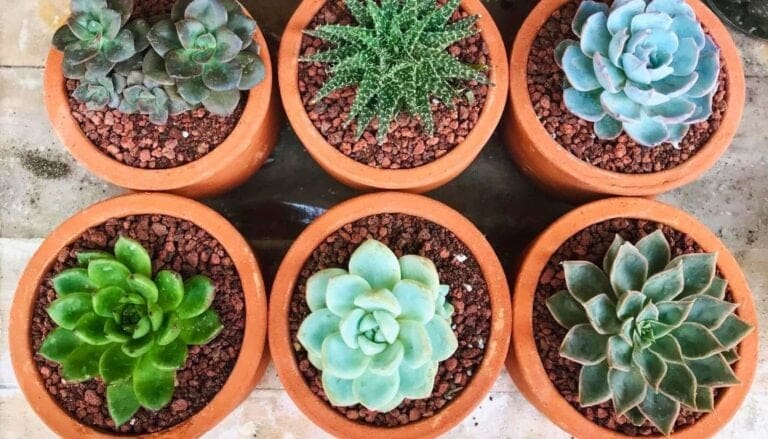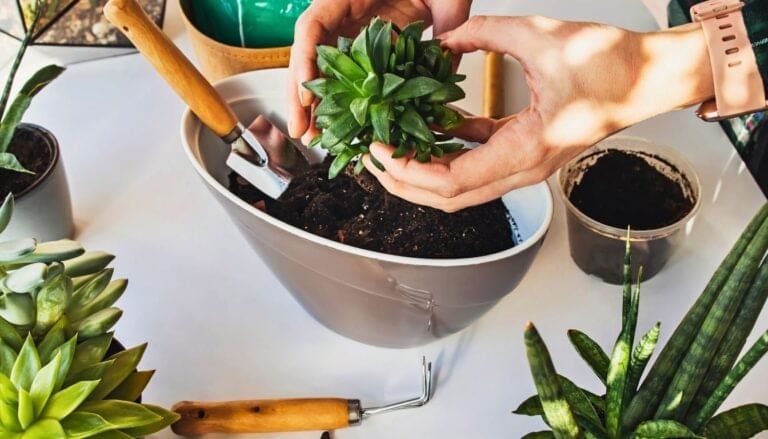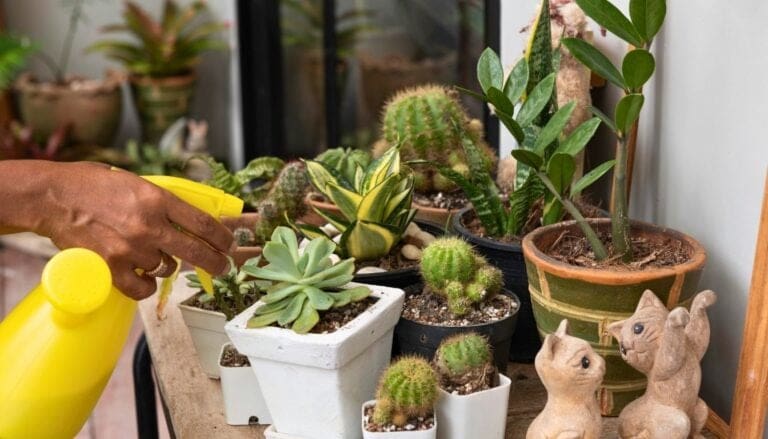7 Tips to Save a Broken Succulent: Revive and Thrive!
I know how it feels when a succulent isn’t doing so well. 😢 Perhaps it’s tipped over, or maybe it’s lost its vibrant color.
Don’t worry—I’ve been there too! Succulents are resilient little plants, and with the right care, they can bounce back.
Whether it’s a slight bruise or a more serious issue, I’ve learned some easy ways to help them thrive again.
Have you ever felt frustrated seeing your favorite plant go limp? I certainly have.
It’s natural to feel unsure of how to fix it. With some time and love, those plants can be beautiful once more.
Stick around, and let’s bring that succulent back to life together!
Let’s dig into it and share some plant-saving tips! 🌿✨

Please note: Simplify Plants is reader-supported. As an Amazon Associate, I earn from qualifying purchases made by our readers with no extra cost added to you all! Some links in the post are affiliate links and I get a commission from purchases made through links in the post.
1) Assess and Trim Damaged Leaves
When I find my succulent looking a bit sad, the first thing I do is check its leaves. Damaged leaves can signal that something is wrong.
I gently touch them, checking for signs of softness or discoloration. If you touch a leaf and it feels mushy or looks brown, it’s time for some tender care.
Once I spot the damaged leaves, I grab my clean scissors or a small knife.
Cutting away those unhealthy parts helps the plant focus its energy on growing new and healthy leaves. A quick snip at the base of the damaged leaf usually does the trick.
Remember, neat cuts heal faster! ✂️
As I trim, I make sure not to take off too much at once. Cutting away only what’s necessary keeps the plant from getting too stressed.
I leave healthy leaves alone so the plant has enough resources to bounce back.
Rather than a drastic haircut, think of it like giving your plant a fresh start! 🌿
Have you ever trimmed your succulents before? It’s easier than giving yourself a bad haircut! 😂
Just be sure to keep those scissors clean to avoid spreading any pesky germs.
After trimming, my succulent always looks a bit happier. Plus, keeping it healthy lets it shine and thrive.
Check your succulent today! You might find a few leaves that need some help.
Remember, it’s all about giving your plant the best chance to grow beautifully again. 🌱✨
2) Gently Remove Plant from Soil

When I notice my succulent looking a bit sad and droopy, the first step is to gently remove it from the soil. Sometimes, it just needs a little breathing room! 🪴
I always start by checking around the base. Carefully, I wiggle the plant a bit while holding the pot steady with the other hand.
Feel like a plant surgeon yet? Stay calm and be gentle so you don’t break those precious roots.
Once I’ve got a good grip, I tip the pot sideways and ease the plant out. It’s like rescuing a delicate treasure.
I pay attention to the clump of soil around the roots. Is it rock hard, or is it nice and crumbly? That gives me clues on how the plant’s been doing.
Are any of the roots damaged or mushy? If so, no problem! I just trim away the unhealthy parts carefully.
It’s important not to stress. This touch of care can make a world of difference! ✂️
Who doesn’t like a little makeover now and then?
After removing the plant, I shake off the old soil gently. Think of it as a fresh start for both of us.
A little kindness to the roots goes a long way in helping the succulent bounce back stronger. 😊
Ever tried doing this yourself? Let me know how it goes or if you have any other tricks!
3) Use a Sterile Knife for Cutting
When I first started caring for succulents, I didn’t realize how important it was to use a sterile knife when trimming.
You might think, “Why does it matter?” Well, using a clean knife prevents infections from spreading to your plant. 🪴 It’s like using a clean fork for your food—nobody wants germs!
To keep the knife sterile, I simply wash it with soap and water. Sometimes, I use rubbing alcohol for an extra clean. It’s super easy!
When the knife is dry, it’s all set for cutting. Do you have a favorite cleaning method?
I like to be gentle when I’m cutting. I make sure to snip at a slight angle to avoid damaging the stem. Precision is key!
Remember, a small cut can make a big difference in your succulent’s life. Get it right, and your plant will thank you with new growth! 🌱
Here’s a quirky tip: I name my succulents to remind myself they need care! 😊
If you give your plant a funny name, like “Mr. Prickles,” you might pay more attention to those little maintenance tasks. What’s the funniest plant name you can think of?
Cutting isn’t scary when I have the right tools and methods. Making my plants happy keeps me happy too.
Let’s get snipping and see those succulents thrive again! Have you tried using a sterile knife before?
4) Let Cuttings Dry for a Few Days

Ever had a succulent that just wouldn’t look happy? 🌵 One thing I found super important is letting the cuttings dry before doing anything else.
After cutting, I always leave my cuttings on a paper towel or a windowsill for a few days. This helps them heal. Did you know this can prevent them from getting all mushy?
When I first tried it, I was surprised! 😊 Just a couple of days lying around changed everything. It seems kind of simple, right?
Imagine trying to plant something that just got cut. It’s like running before you’ve learned to walk!
Some of my succulents were saved just by this drying step. Have you tried this yet?
For anyone who’s impatient, take a deep breath. I know waiting can be tough.
Especially when you’re excited to see new roots growing. But trust me, it really is worth it!
Keep an eye on those cuttings, and watch your succulent game improve!
What about a nice little plant chat with friends?
Next time someone has succulent issues, spread the word about this drying trick. Maybe even show off some of your now-thriving plants. 🌱
5) Root Succulents in Fresh Soil
I know it can be heartbreaking to see your succulent looking sad and droopy. 🌵 But don’t worry, I’ve been there too!
Rooting your succulent in fresh soil can make a world of difference. Let’s get our hands dirty, shall we?
First, gently remove the succulent from its current pot. Be careful not to damage the roots when you do this. Sometimes, it’s like separating two best friends who need a little space!
Fresh soil is key!
Old soil can be compacted and may not provide the nutrients your succulent needs. I like to use cactus soil mix because it’s super light and drains well. If you’re feeling adventurous, mix in some perlite for extra drainage.
Now for the exciting part! Place the succulent in its new pot. Make sure it’s centered and standing tall.
Fill in the gaps with fresh soil, but avoid burying the leaves.
Remember, succulents like their space, just like we do sometimes!
Watering time! Give your succulent a small drink. Not too much though—overwatering can be a big no-no 💦.
Just a sip to help settle it in.
Have you ever had a plant that bounced back better than ever? It feels amazing, right?
I’d love to hear your succulent success stories! Share a pic and tag me. Let’s grow these beauties together! 🌱
6) Avoid Overwatering Rooted Cuttings

Isn’t it tempting to care for our plants a bit too much? 🌱 I know the feeling!
Succulents store water in their leaves, so they don’t need much from us. Overwatering can actually harm their little roots.
When my succulents seemed sad, I learned to love them by giving less water. Sounds backward, right?
Let’s change our mindset: less is more!
I check the soil first. If it’s still moist, I hold off on watering.
Picture this: your succulent sitting in soggy soil, crying out, “Help, I’m drowning!
We wouldn’t want that, would we? 😂
I make sure their pots have proper drainage and only water every one to two weeks.
Feel the soil with your finger. It’s a simple trick. If it’s dry up to the first knuckle, it might be thirsty. Otherwise, it’s all set.
Sometimes, I give them space to breathe instead of rushing with more water.
Curious about the right amount?
I use just enough to moisten the soil but avoid puddles. Too much water? Bad news for our leafy friends.
Let’s aim to give them a balanced sip, not a giant gulp.
Who else checks the weather for their plants?
If it’s rainy, I skip watering. Succulents thrive in dry conditions, so let’s mimic their happy place.
Engage with me—how do you make sure your succulents stay healthy and happy without overdoing the water? 💧
7) Provide Indirect Bright Light
I’ve been guilty of placing my succulents directly in the sun, thinking they’d love it. 🌞
Wrong move!
Succulents actually thrive in bright, indirect light. Direct sunlight can scorch their leaves, leaving them crispy and sad.
Think of it like yourself sitting in the sun all day without sunscreen. Not comfy, right?
Instead, I find a spot that gets lots of light, but not the intense midday sun directly hitting the plants. A bright windowsill with filtered light is perfect.
This way, they can soak up enough energy without the risk of sunburn.
Do you have a favorite window where the sun isn’t too harsh?
Try experimenting with different windows and see where your succulents smile brightest. 😊
Watch their colors and growth to know if they’re happy with the light they’re getting.
Ever notice the leaves stretching or changing color? It could be a sign they need more light.
Arrange your plants according to their needs and keep an eye out for any changes.
It’s like having a mini jungle scouting adventure right inside my home! 🏡
Remember, finding the right spot takes a bit of trial and error.
Be prepared to move them around until the lighting is just right.
Not only will your succulents thank you, but you might also find yourself with a greener thumb! 🌿
Understanding Succulent Health

Taking care of succulents can be tricky because these little guys don’t always show us they’re struggling until it’s too late. I’ll show you common signs that your succulent might be having a tough time and some factors that can affect its growth. 🌵
Common Signs of a Dying Succulent
Have you noticed your succulent looks a bit sad?
One red flag is yellowing leaves. Yellow leaves can hint that the roots are sitting in too much water.
Have you been overly generous with the watering can? Maybe it’s time to back off a bit.
Are the leaves falling off more than usual? A couple here and there is normal, but constant leaf drop is not.
Weak roots or sudden temperature changes can shock your plant. 😲 Keep an eye out!
Another clue might be brown spots or mushy leaves. This can mean rot is setting in.
Check if you’ve left water sitting in the pot. Handy tip: succulents love dry feet!
Factors That Impact Succulent Growth
A healthy succulent needs the right mix of light, water, and soil. Too much sun can scorch them, while too little makes them leggy.
Aim for bright, indirect light. I like to rotate mine so all sides get a fair share. ☀️
Watering is tricky! I follow the “soak, then dry completely” method. Not too hard, right?
Also, choosing the right soil can make a world of difference. Look for a well-draining mix to keep your darling plant happy.
Temperature and humidity are sneaky factors. Most prefer a dry environment.
Make sure to keep them cozy during cold months, but not too close to heaters.
Anyone else feeling the succulent love? 🪴
Soil and Watering Best Practices

I’m thrilled to talk about these two key elements to save your broken succulent: soil and watering. Believe me, these make all the difference in keeping your plant happy and thriving.
Get your hands a little dirty and find the joy in watering your succulent right 😉
Choosing the Right Soil Mix
The right soil can make your succulent feel at home. When I pick out soil, I make sure it’s fast-draining.
Using regular potting soil isn’t the best. I like using a mix of cactus soil, perlite, and coarse sand.
This combo helps avoid waterlogged roots. 🪴
You can find pre-mixed succulent soil at most garden stores, but making your mix gives you control. Plus, it’s fun!
Mixing your own also allows you to adjust the texture to your liking. Experiment until your plant seems to smile back at you 😊.
Consistency matters here, so stick to what works for your little buddy!
Optimal Watering Techniques
Watering can be tricky, right? I use the “soak and dry” method.
What this means is I water my succulent until the soil is completely soaked. Then, I let it dry out totally before watering again.
This mimics their natural desert conditions. Too much love here can actually harm, so hold back a bit!
Also, I often water in the morning. Why?
This way the plant can soak up what it needs throughout the day, while the soil dries out at night.
Want to hear something funny? I have a little schedule to remind me when water day is. Go ahead, create one too! It helps a lot. 💧
By keeping these tips in mind, you’re well on your way to reviving your succulent!
Don’t forget to share your progress with a photo—I’d love to see it! 📷
Sunlight and Temperature Requirements
To save your succulent, it’s crucial to give it the right light and temperature. These plants love sunshine but can get sunburned. Temperature also plays a big role in their health, so let’s make sure they stay happy and cozy.
Ideal Sun Exposure
When it comes to light, succulents love the sun, but not too much!
I always make sure mine get about 6 hours of bright, indirect sunlight each day.
Shields like sheer curtains or placing them near a south-facing window work wonders. If they start looking a bit pale or stretched, it’s a sign they need more light.
Watch out for sunburn! Just like us, succulents can burn. Brown or white patches are a big clue.
Do you find your plant looking a little crispy? Maybe try moving it to a spot with partial shade. Or switch them around during the day to let them adapt gradually. 🌿
Maintaining Proper Temperature
Succulents are fans of warmer weather but can get quite grumpy if it’s too hot or too cold.
I keep mine in spaces where the temperature stays between 60°F and 80°F.
Cooler than that, and they might start to sulk. Warmer? They could dry out or even scorch. 😬
A surprising trick is to give them a buddy to cozy up to if it gets really chilly!
Maybe another plant or a decorative stone which can keep them company.
But, what do you do if it’s too hot?
A small fan can circulate air and make them feel as fresh as a daisy. 🌸
How do you manage your succulent’s climate? I’d love to know!
Frequently Asked Questions
I’ve collected some common questions about healing a broken succulent. Let’s dive into how you can get your green buddies back on track. 🌵
How can I help a succulent recover from a broken stem?
When a stem breaks, I trim the damaged parts with a clean, sharp knife. This keeps diseases away.
After trimming, I let the cut part dry for a few days. Then, I place it in fresh soil to help it root again.
Is it possible for a succulent to regrow after being broken?
Yes, it is! Succulents are tough little plants. Even if they break, they can regrow.
I just need to give them some extra care like proper light and watering.
What should I do if a leaf from my succulent breaks off?
Don’t panic! Place the leaf on dry soil and wait a week or two. Over time, it might develop roots.
Rooting hormone can help speed up this process.
What are the stages of succulent leaf propagation?
First, I let the leaf dry out for a few days.
Next, I place it on top of the soil surface. Eventually, it sprouts tiny roots or even a cute little plantlet.
Patience is key!
Can a dead succulent be brought back to life?
If the stem feels mushy, it might be too late. 😢
But, if there’s some green left, I trim away the dead parts and check the roots. A last attempt in fresh soil can sometimes work miracles.
What causes succulents to develop long stems and flowers?
When succulents grow long stems, they’re reaching for more light. This process is called etiolation.
I move mine closer to a window or under a grow light. And those flowers? They’re a sign of a happy plant! 🌼
Recommended Garden Supplies
| Product Image | Our Recommended Gardening Supplies | Check Offers! |
|---|---|---|
Top Top
Top
Top
Top
Top
Top
Top
Top | rePotme Houseplant and Tropical Classic Potting Soil Mix | Check Offer On Amazon |
 Top
Top
Top
Top
Top
Top
Top
Top | Espoma Organic Indoor Plant Food | Check Offer On Amazon |
 Top
Top
Top
Top
Top
Top
Top
Top | GooingTop LED Grow Light 6000K Full Spectrum Clip Plant Growing Lamp | Check Offer On Amazon |
 Top
Top
Top
Top
Top
Top
Top
Top | Soil Moisture Meter | Check Offer On Amazon |
 Top
Top
Top
Top
Top
Top
Top
Top | Govee Hygrometer Thermometer, Bluetooth Enabled! | Check Offer On Amazon |
 Top
Top | LEVOIT Humidifiers for Large Room(Best For Plants) | Check Offer On Amazon |
 Top
Top
Top
Top
Top
Top
Top
Top | Upgraded DIY Automatic Drip Irrigation Kit, 15 Potted Houseplants Support | Check Offer On Amazon |
 Top
Top
Top
Top
Top
Top
Top
Top | Stainless Steel Heavy Duty Gardening Tool Set | Check Offer On Amazon |
 Top
Top
Top
Top
Top
Top
Top
Top | Bonide Insecticidal Soap | Check Offer On Amazon |
 Top
Top
Top
Top
Top
Top
Top
Top | Bonide 32 oz Spray Neem Oil for Organic Gardening | Check Offer On Amazon |
 Top
Top
Top
Top
Top
Top
Top
Top | Garden Safe Fungicide | Check Offer On Amazon |







Hi. I am not sure if I should continue saving my succulent. My other type of succulents strive with regular soil and love bigger pots to grow, so I did the same with my succulent which actually drown it. I did not know what was wrong except watching its leaves getting worse. When I finally found the answer, it was already rotten close to the tip. I cut out the rot which only the crown was left. It took a few weeks for this succulent crown to have scap and it eventually got 2 tiny air root after 4 months. I placed it on a well drained succulent soil and tested the water drainage. I do live in a cold weather location and the house is quite cold. It seems alive through the winter but not growing. I don’t think its roots are even in the soil. I don’t check the root so I don’t have to move it. Spring is coming. Should I give it more time? Its leaves look a little wrinkled up and I do give it a few drops of water every other week and it’s close to the bathroom for extra moist in the air. It’s also by a south facing window for good indirect sunlight. Please help us. It’s been 8 months since it was hurt.
You’ve done a great job caring for your succulent through a tough situation! With spring coming and more light, there’s a good chance it will perk up and start growing again. Succulents can be very slow to recover, especially in cooler, low-light conditions. Keep giving it bright, indirect light and only water when the soil is completely dry. Once it’s warmer, you might see new root or leaf growth. Don’t give up yet—your succulent still has a chance!